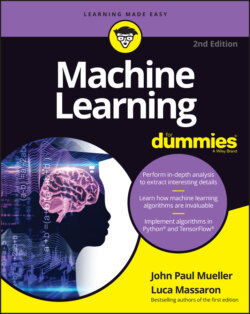Читать книгу Machine Learning For Dummies - John Paul Mueller, John Mueller Paul, Luca Massaron - Страница 15
Understanding the history of AI and machine learning
ОглавлениеThere is a reason, other than anthropomorphization, that humans see the ultimate AI as one that is contained within some type of android. Ever since the ancient Greeks, humans have discussed the possibility of placing a mind inside a mechanical body. One such myth is that of a mechanical man called Talos (http://www.ancient-wisdom.com/greekautomata.htm). The fact that the ancient Greeks had complex mechanical devices, only one of which still exists (read about the Antikythera mechanism at http://www.ancient-wisdom.com/antikythera.htm), makes it quite likely that their dreams were built on more than just fantasy. Throughout the centuries, people have discussed mechanical persons capable of thought (such as Rabbi Judah Loew's Golem, https://www.nytimes.com/2009/05/11/world/europe/11golem.html).
AI is built on the hypothesis that mechanizing thought is possible. During the first millennium, Greek, Indian, and Chinese philosophers all worked on ways to perform this task. As early as the seventeenth century, Gottfried Leibniz, Thomas Hobbes, and René Descartes discussed the potential for rationalizing all thought as simply math symbols. Of course, the complexity of the problem eluded them (and still eludes us today, despite the advances you read about in Part 3 of this book). The point is that the vision for AI has been around for an incredibly long time, but the implementation of AI is relatively new.
The true birth of AI as we know it today began with Alan Turing’s publication of “Computing Machinery and Intelligence” in 1950 (https://www.csee.umbc.edu/courses/471/papers/turing.pdf). In this paper, Turing explored the idea of how to determine whether machines can think. Of course, this paper led to the Imitation Game involving three players. Player A is a computer and Player B is a human. Each must convince Player C (a human who can’t see either Player A or Player B) that they are human. If Player C can’t determine who is human and who isn’t on a consistent basis, the computer wins.
A continuing problem with AI is too much optimism. The problem that scientists are trying to solve with AI is incredibly complex. However, the early optimism of the 1950s and 1960s led scientists to believe that the world would produce intelligent machines in as little as 20 years. After all, machines were doing all sorts of amazing things, such as playing complex games. AI currently has its greatest success in areas such as logistics, data mining, and medical diagnosis.
